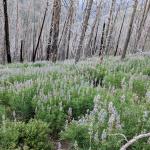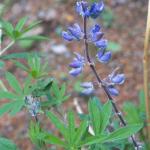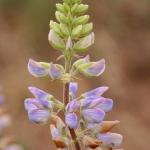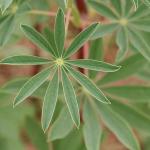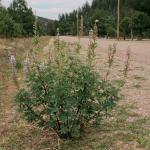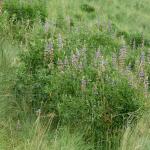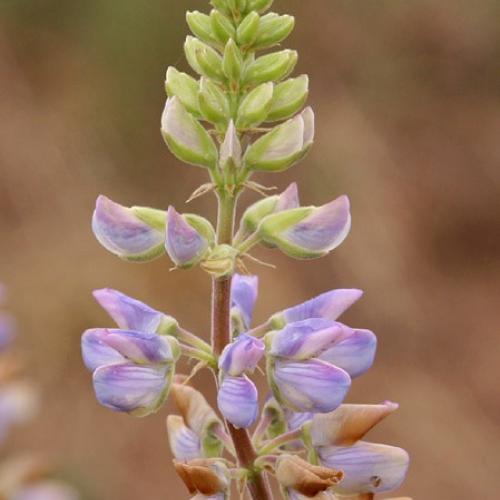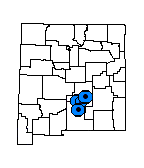Lupinus sierrae-blancae (Sierra Blanca Lupine)
LUPINUS AQUILINUS WOOTON & STANDLEY; LUPINUS SIERRAE-BLANCAE WOOTON & STANDLEY SSP. AQUILINUS (WOOTON & STANDLEY) FLEAK & DUNN
| USFWS | State of NM | USFS | BLM | Navajo Nation | State Rank | Global Rank | R-E-D Code | NMRPTC Status | Strategy Status |
|---|---|---|---|---|---|---|---|---|---|
| S3 | G3 | 1-1-3 | R | SS |
| Overall Conservation Status | Documented Threats | Actions Needed |
|---|---|---|
| WEAKLY CONSERVED | No Information |
document rarity |
Perennial herb to 1.5 m tall, finely and inconspicuously pubescent; leaves palmately compound, with long petioles, leaflets 7-9, 3-7 cm long, oblong-oblanceolate, finely strigose below, glabrate above; racemes 10-30 cm long, flowers irregularly whorled or scattered; calyx 8-10 mm long, the lips subequal or the lower longer; corolla 10-14 mm, pale blue and whitish; upper petal glabrous; keel upturned about 90-120 degrees, generally sparsely ciliate near the tip; pods about 3.5 cm long, 8 mm deep, hirsute. Flowers July to September.
None in the region. There are several tall lupine species to the north, and in the mountains of Mexico. These differ by leaflet number and by pubescence characteristics, particularly of the upper petal, the keel, and the fruit.
New Mexico, Lincoln and Otero counties.
Meadows and roadsides in pine and fir forest; 1,800-3,000 m (5,900-11,000 ft).
Fleak and Dunn (1971) placed Lupinus aquilinus, which is also endemic to the Sacramento Mountains, as a subspecies of L. sierrae-blancae noting that ssp. aquilinus differs from ssp. sierrae-blancae by its shorter racemes, on average smaller narrower leaflets, and slightly different habitat preference. Isely (1998) questioned the placement of L. aquilinus in L. sierrae-blancae, suggesting instead that it could be an inconspicuously pubescent form of L. argenteus var. argenteus, a common northern taxon. Nevertheless, he included the ssp. aquilinus as a synonym within L. sierrae-blancae.
Although restricted to a small area in the south-central mountains of New Mexico, the species is locally common. It is also somewhat weedy, occurring on open roadsides and road banks. There is no evidence that the species is in need of management to sustain present populations. Lupinus sierrae-blancae was the dominant understory story species in severely burned forests 8 years following the 2012 Little Bear Fire in the Sierra Blanca region above 10,000 ft.
*New Mexico Native Plants Protection Advisory Committee. 1984. A handbook of rare and endemic plants of New Mexico. University of New Mexico Press, Albuquerque.
Fleak, L.S. and D.B. Dunn. 1971. Nomenclature of the Lupinus sericeus complex (Papilionaceae). Transactions of the Missouri Academy of Science 5:88.
Isley, D. 1998. Native and naturalized Leguminosae (Fabaceae) of the United States. Monte L. Bean Life Science Museum, Brigham Young University, Provo, Utah.
Wooton, E.O. and P.C. Standley. 1913. Descriptions of new plants preliminary to a report upon the flora of New Mexico. Contributions from the U.S. National Herbarium 16:109-196.
For distribution maps and more information, visit Natural Heritage New Mexico

